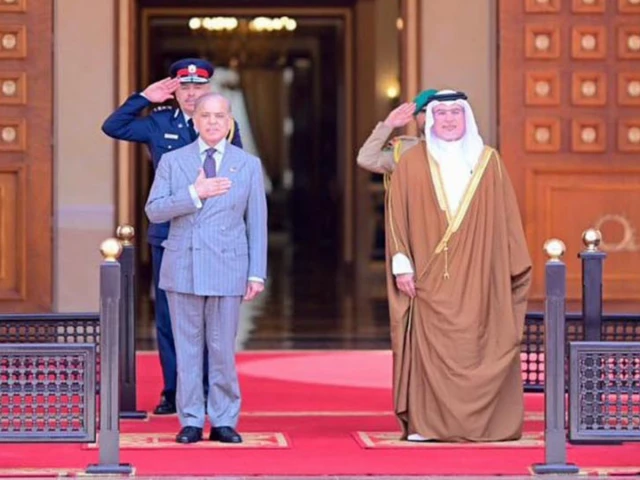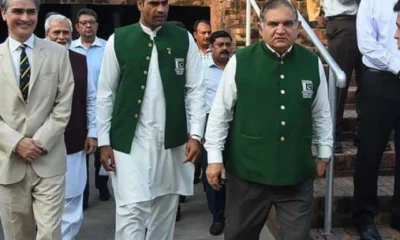Business
IMF Mission to Visit Pakistan on Sept 25 for Second Review of $7bn Loan Program – SUCH TV

The International Monetary Fund (IMF) team is set to visit Pakistan on September 25 to conduct the second review under the $7 billion Extended Fund Facility (EFF), The News reported on Friday. This visit aims to assess the country’s progress on economic reforms and fiscal targets agreed with the IMF.
In the wake of devastating floods, the macroeconomic framework might have to be revised downward/re-adjusted, including the real GDP growth rate, CPI-based inflation, monetary policy, exports, imports, and tax revenues for the current fiscal year.
The GDP growth is likely to be revised downward from 4.2% due to the severe impact on the agriculture sector and possible escalation in inflationary pressures owing to supply disruptions of food items.
The CPI-based inflation might go up beyond the envisaged target of 5% to 7% for the current fiscal year.
The export sector might also witness a dip, especially in rice exports, and import,s which are expected to witness a surge mainly because of damage to the farm sector caused by floods.
The trade deficit had already widened before the floods. The implementation of Agriculture Income Tax (AIT) will also be discussed in detail, as the IMF will seek details about its potential for collection.
The tax revenue target for the end of September 2025 will also become a major headache for the Pakistani negotiators in the upcoming review talks.
The delay in releasing the Governance and Corruption Diagnostic (GDC) Assessment report has proved another bone of contention between the two sides because Islamabad had not granted permission to the IMF to release its report.
The IMF had publicly committed to publish this GCD Assessment Report by the end of August 2025, but this deadline was already missed.
“The IMF review mission is scheduled to visit Pakistan from September 25 to October 8, 2025, for second review talks and release of the third tranche worth $1.1 billion under EFF.
Both sides will have to strike an agreement on the Memorandum of Economic and Financial Policies (MEFP) for making re-adjustment in macroeconomic numbers aligned with the realities emerged on continuous devastating floods,” top official sources confirmed while talking to the publication.
Pakistan is committed to amend the Sovereign Wealth Fund (SWF) Act and other legislation, in consultation with Fund staff and in line with MEFP to adopt appropriate governance mechanisms and safeguards.
following international standards and good practices to (i) ensure that SOEs under the ownership of the SWF revert to the SOE Act’s governance principal nature as a holding company, and appropriate fiscal safeguards are in place for the SWF’s operations by end March 2026.
The review talks will take place in two stages: technical talks followed by policy-level negotiations.
The IMF team will engage with the Ministry of Finance, Ministry of Energy, Ministry of Planning, the State Bank of Pakistan, and regulatory bodies such as FBR, OGRA and NEPRA.
Separate rounds of talks will also be held with provincial governments of Punjab, Sindh, Khyber Pakhtunkhwa and Balochistan.
Pakistan has so far received $2.1 billion under the $7 billion EFF arrangement.
To secure the next tranche, however, the government will have to demonstrate progress on structural reforms and bridge a significant fiscal gap.
The Federal Board of Revenue (FBR) has been tasked with collecting Rs. 3.1 trillion during July–September, but in the next two weeks alone, it will need to mobilise nearly Rs. 1.1 trillion to hit the quarterly target.
The FBR envisages tax collection target of Rs1.385 trillion for September 2025.
However, keeping in view the shortfall so far in the first two months, the FBR requires a collection of Rs1.44 trillion in September to materialise the desired target of Rs 3.08 trillion on September 30, 2025.
The FBR had envisaged an annual tax collection target of Rs14.13 trillion for the current fiscal year.
The revenue collection efforts were hampered by recent floods and lower receipts from utilities, leaving the FBR with a shortfall of Rs50 billion.
Of this, more than Rs25 billion in tax losses are directly linked to flood damage in Punjab, where the overall impact is estimated at Rs34 billion.
Tax offices from Sialkot to Bahawalpur have reported less collections than half of normal levels, while nine field formations, including Lahore, Gujranwala, Multan, Sahiwal, and Sargodha, have all seen significant declines.
The FBR requires a 21% year-on-year growth in tax collection to meet its July–September target, but collections until August had grown only 15%.
With these slippages and structural issues, Pakistan is expected to face tough negotiations with the IMF mission later this month.
This scribe sent a message to the Ministry of Finance spokesman and inquired about the expectation from the upcoming review talks, but got no reply till the filing of this report.
Business
Key Financial Deadlines That Have Been Extended For December 2025; Know The Last Date

New Delhi: Several crucial deadlines have been extended in December 2025, including ITR for tax audit cases, ITR filing and PAN and Aadhaar linking. These deadlines will be crucial in ensuring that your financial affairs operate smoothly in the months ahead.
Here is a quick rundown of the important deadlines for December to help you stay compliant and avoid last-minute hassles.
ITR deadline for tax audit cases
The Central Board of Direct Taxes has extended the due date of furnishing of return of income under sub-Section (1) of Section 139 of the Act for the Assessment Year 2025-26 which is October 31, 2025 in the case of assessees referred in clause (a) of Explanation 2 to sub-Section (1) of Section 139 of the Act, to December 10, 2025.
Belated ITR filing deadline
A belated ITR filing happens when an ITR is submitted after the original due date which is permitted by Section 139(4) of the Income Tax Act. Filing a belated return helps you meet your tax obligations, but it involves penalties. You can only file a belated return for FY 2024–25 until December 31, 2025. However, there will be a late fee and interest charged.
PAN and Aadhaar linking deadline
The Income Tax Department has extended the deadline to link their PAN with Aadhaar card to December 31, 2025 for anyone who acquired their PAN using an Aadhaar enrolment ID before October 1, 2024. If you miss this deadline your PAN will become inoperative which will have an impact on your banking transactions, income tax return filing and other financial investments.
Business
Stock Market Live Updates: Sensex, Nifty Hit Record Highs; Bank Nifty Climbs 60,000 For The First Time

Stock Market News Live Updates: Indian equity benchmarks opened with a strong gap-up on Monday, December 1, touching fresh record highs, buoyed by a sharp acceleration in Q2FY26 GDP growth to a six-quarter peak of 8.2%. Positive cues from Asian markets further lifted investor sentiment.
The BSE Sensex was trading at 85,994, up 288 points or 0.34%, after touching an all-time high of 86,159 in early deals. The Nifty 50 stood at 26,290, higher by 87 points or 0.33%, after scaling a record intraday high of 26,325.8.
Broader markets also saw gains, with the Midcap index rising 0.27% and the Smallcap index advancing 0.52%.
On the sectoral front, the Nifty Bank hit a historic milestone by crossing the 60,000 mark for the first time, gaining 0.4% to touch a fresh peak of 60,114.05.
Meanwhile, the Metal and PSU Bank indices climbed 0.8% each in early trade.
Global cues
Asia-Pacific markets were mostly lower on Monday as traders assessed fresh Chinese manufacturing data and increasingly priced in the likelihood of a US Federal Reserve rate cut later this month.
According to the CME FedWatch Tool, markets are now assigning an 87.4 per cent probability to a rate cut at the Fed’s December 10 meeting.
China’s factory activity unexpectedly slipped back into contraction in November, with the RatingDog China General Manufacturing PMI by S&P Global easing to 49.9, below expectations of 50.5, as weak domestic demand persisted.
Japan’s Nikkei 225 slipped 1.6 per cent, while the broader Topix declined 0.86 per cent. In South Korea, the Kospi dropped 0.30 per cent and Australia’s S&P/ASX 200 was down 0.31 per cent.
US stock futures were steady in early Asian trade after a positive week on Wall Street. On Friday, in a shortened post-Thanksgiving session, the Nasdaq Composite climbed 0.65 per cent to 23,365.69, its fifth consecutive day of gains.
The S&P 500 rose 0.54 per cent to 6,849.09, while the Dow Jones Industrial Average added 289.30 points, or 0.61 per cent, to close at 47,716.42.
Business
South Korea: Online retail giant Coupang hit by massive data leak

Osmond ChiaBusiness reporter
 Getty Images
Getty ImagesSouth Korea’s largest online retailer, Coupang, has apologised for a massive data breach potentially involving nearly 34 million local customer accounts.
The country’s internet authority said that it is investigating the breach and that details from the millions of accounts have likely been exposed.
Coupang is often described as South Korea’s equivalent of Amazon.com. The breach marks the latest in a series of data leaks at major firms in the country, including its telecommunications giant, SK Telecom.
Coupang told the BBC it became aware of the unauthorised access of personal data of about 4,500 customer accounts on 18 November and immediately reported it to the authorities.
But later checks found that some 33.7 million customer accounts – all in South Korea – were likely exposed, said Coupang, adding that the breach is believed to have begun as early as June through a server based overseas.
The exposed data is limited to name, email address, phone number, shipping address and some order histories, Coupang said.
No credit card information or login credentials were leaked. Those details remain securely protected and no action is required from Coupang users at this point, the firm added.
The number of accounts affected by the incident represents more than half of South Korea’s roughly-52 million population.
Coupang, which is founded in South Korea and headquartered in the US, said recently that it had nearly 25 million active users.
Coupang apologised to its customers and warned them to stay alert to scams impersonating the company.
The firm did not give details on who is behind the breach.
South Korean media outlets reported on Sunday that a former Coupang employee from China was suspected of being behind the breach.
The authorities are assessing the scale of the breach as well as whether Coupang had broken any data protection safety rules, South Korea’s Ministry of Science and ICT said in a statement.
“As the breach involves the contact details and addresses of a large number of citizens, the Commission plans to conduct a swift investigation and impose strict sanctions if it finds a violation of the duty to implement safety measures under the Protection Act.”
The incident marks the latest in a series of breaches affecting major South Korean companies this year, despite the country’s reputation for stringent data privacy rules.
SK Telecom, South Korea’s largest mobile operator, was fined nearly $100m (£76m) over a data breach involving more than 20 million subscribers.
In September, Lotte Cards also said the data of nearly three million customers was leaked after a cyber-attack on the credit card firm.
-

 Sports1 week ago
Sports1 week agoWATCH: Ronaldo scores spectacular bicycle kick
-

 Entertainment1 week ago
Entertainment1 week agoWelcome to Derry’ episode 5 delivers shocking twist
-

 Politics1 week ago
Politics1 week agoWashington and Kyiv Stress Any Peace Deal Must Fully Respect Ukraine’s Sovereignty
-

 Business1 week ago
Business1 week agoKey economic data and trends that will shape Rachel Reeves’ Budget
-

 Tech6 days ago
Tech6 days agoWake Up—the Best Black Friday Mattress Sales Are Here
-

 Fashion7 days ago
Fashion7 days agoCanada’s Lululemon unveils team Canada kit for Milano Cortina 2026
-

 Tech6 days ago
Tech6 days agoThe Alienware Aurora Gaming Desktop Punches Above Its Weight
-

 Politics1 week ago
Politics1 week ago53,000 Sikhs vote in Ottawa Khalistan Referendum amid Carney-Modi trade talks scrutiny














